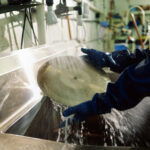Experts have suggested reasons why a reduction of Campylobacter in chicken meat has not led to a decrease in infections in the United Kingdom. Ideas include the selected meat contamination target being the wrong one to focus on as well as the role of other sources of infection and imported… Continue Reading Food Policy & Law, Foodborne Pathogens, World, Campylobacter, campylobacter retail survey, chicken, Food Standards Agency (FSA) Food Safety News
Experts have suggested reasons why a reduction of Campylobacter in chicken meat has not led to a decrease in infections in the United Kingdom.
Ideas include the selected meat contamination target being the wrong one to focus on as well as the role of other sources of infection and imported poultry meat.
Campylobacter is the leading bacterial cause of foodborne illness in the UK. Cases are frequently attributed to chicken. In 2010, the FSA began a Campylobacter reduction program to reduce contamination levels in poultry.
With help from industry, there was a reduction in the proportion of chickens contaminated with Campylobacter at levels above 1,000 colony forming units per gram (CFU/g) at retail from 19 percent in 2014 to 5 percent in 2017; recent data indicates these levels have been maintained. However, human cases have remained stable at around 100 per 100,000 population between 2014 and 2019.
When setting the original target, modelling suggested that introducing interventions at farm and slaughterhouse level could lead to a 15 to 30 percent reduction in human cases.
FSA is reviewing its Campylobacter campaign to understand why the reduction in prevalence in chicken meat was not associated with a decrease in sick people.
An expert elicitation exercise was run to generate hypotheses that might explain this finding.
Proposed reasons behind situation
Forty-one experts from the UK, Ireland, Denmark, the Netherlands, and France were recruited with experience in either poultry production or Campylobacter research. More experts from academia, followed by government, were represented compared to industry participants.
They individually generated 157 hypotheses, which later became 25 ideas.
As the campylobacteriosis case trends analysis demonstrated, the UK is not the only country to see case numbers remain steady, or increase, despite public health efforts and industry intervention strategies.
Eight suggestions were put forward as likely explanations for campylobacteriosis case numbers not following the trends seen with levels in chickens at retail.
These included the role of imported poultry meat, other food sources, the low infectious dose meaning the 1,000 CFU/g target was not strict enough, sampling the wrong products or areas, or at the wrong times, and a lack of food hygiene in consumer kitchens.
Ranked hypotheses will be considered by FSA scientists and policy colleagues to help focus the agency’s research and explore new strategies to reduce infections in humans.
In 2019, the Advisory Committee for the Microbiological Safety of Food (ACMSF) published a report on the management of Campylobacter, finding no single practical intervention has been shown to be capable of eliminating it. A 2024 report from the FAO and WHO found combining interventions was necessary to significantly impact Campylobacter levels and prevalence in poultry meat.
(To sign up for a free subscription to Food Safety News, click here.)









